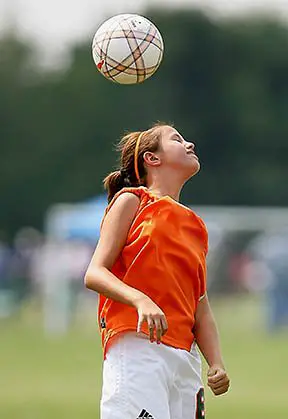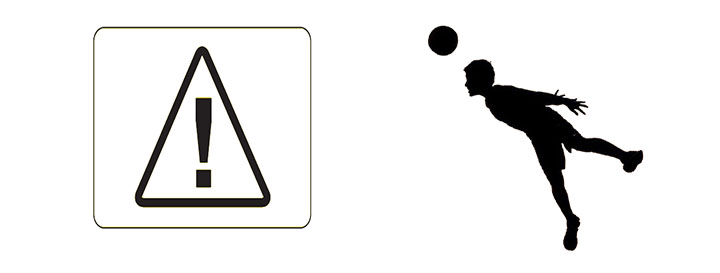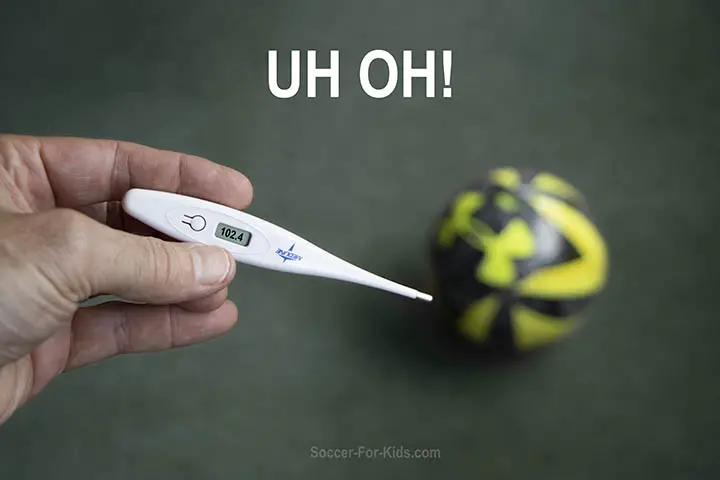When it's Safe To Head a Soccer Ball
(Youth Soccer Safety)

It's important to know when it's safe for kids to head a soccer ball. Heading the soccer ball is an integral part of the game of soccer, but recent medical studies have revealed both the short term and long term dangers of repeated concussions from playing soccer.
Fortunately, the large majority of concussions from heading a soccer ball can be fully recovered from, but it's still prudent to follow the age-related guidelines for when it's safe to head a soccer ball. The general rule is that the older a child is the safer it is for him or her to head the soccer ball.
Here are the specific rules to follow regarding when heading a soccer ball is permitted.
SOCCER HEADING SAFETY RULES
| AGE | WHAT HEADING IS PERMITTED | |
| UNDER 11 YEARS OLD | No heading allowed. Coaches are not allowed to teach heading techniques. | |
| 11-13 YEARS OLD | Players have to limit the total number of headers to between 15 and 20 per week. Practice heading can not be done for more than 30 minutes each week. | |
| 14 YEARS AND OLDER | No limitations. (But coaches need to refrain from excessive force and repetitive frequency of heading.) |
Kids that are 10 years old or younger are no longer allowed to head the soccer ball in either games or during practice. Also, 11-13 year olds can only head the ball as follows. This age group of soccer players can only average a few headers per day and do no more than 30 minutes of practice heading each week.
why was soccer ball heading banned for young people
Research done by the New York Times found that nearly 50,000 high school soccer players sustained concussions playing soccer in 2010 alone. That prompted a need to take measures to make soccer safer to play, particularly for young people with developing brains.
The Glasgow Brain Injury Research Group (GBIRG) did an extensive study on the influence of contact sports on lifelong health and dementia risk. Also, an article by the BBC on the new FA (Football Association-soccer is called football in Europe) on the safety of soccer for children.
Both posts are well worth reading if you want more detailed information.
No more heading the soccer ball for young kids
A group of concerned parents joined together for a class-action lawsuit, and after more than a year of litigation, the changes in the rules were made to improve the safety of soccer for children.
"The United States Soccer Federation and the other youth member defendants, with input from counsel for the plaintiffs, have developed a sweeping youth soccer initiative designed to (a) improve concussion awareness and education among youth coaches, referees, parents and players; (b) implement more uniform concussion management and return-to-play protocols for youth players suspected of having suffered a concussion; (c) modify the substitution rules to insure such rules do not serve as an impediment to the evaluation of players who may have suffered a concussion during games; and (d) eliminate heading for children 10 and under and limit heading in practice for children between the ages of 11 and 13..."
preschool kids heading the ball

Before 2015, the coaching curriculum used by a soccer franchise that specializes in 2-8 year olds, used heading as one of its lesson plans each season. Before you get too upset, let me explain how we introduced "heading" the soccer ball to the very young soccer players.
The children would stand still, just a few feet in front of the goal, with the coach kneeling down next to the player. The couch would ask permission first. If we got a positive answer we would gently touch our size 3 soccer ball to their forehead and allow it to drop to the ground in front of the child. At that point the child would dribble to and shoot at the net and score a goal.
Why did we introduce heading the ball at such a young tender age? It was not to teach them heading, but rather let them know not to be afraid of the soccer ball, and also to let them know that soccer-ball-to-head contact was allowed as part of the game. Once US Soccer unveiled its concussion protocol for youth soccer, it was removed from the curriculum.
what are symptoms of a concussion from heading the soccer ball
If you suspect a possible concussion in your young soccer player, here are some of the classic symptoms to watch out for. This list does not replace a diagnosis by a properly trained medical authority.
Slow reaction to stimuli
Confusion
Dizziness
Memory loss
Sensitivity to light or noise
Double or blurred vision
Drowsiness or sluggish behavior
Nausea or vomiting
Loss of Consciousness
Headache
Balance Problems
what to do if a young soccer player may be concussed from soccer
Every soccer league or club school should have a specific protocol. Be sure to follow the protocol, along with your doctor’s instructions. The list below
- Remove the child from the soccer field immediately. Avoid physical and mental exertion.
- Make an initial observation, including watching for any of the symptoms list above. Symptoms may be more apparent if you engage the child with questions and watch for signs of a possible concussion.
- See a doctor as soon as possible, even if symptoms are not immediate. Symptoms can appear hours or days later. If symptoms are severe go to a medical emergency facility immediately.
CLOSING thoughts on the danger of heading the soccer ball
I hope you found this post helpful. Concussions are possible for young soccer players to suffer from, but research shows that most concussions are NOT FROM repeatedly heading the soccer ball. Concussion are more likely to be caused by collisions with other players, a physical structure like the goal post or the ground, or when the soccer ball is kicked into the head.
All physical sports like soccer have a risk of injury. Soccer moms and dads have to consider the risks and the rewards of having their child play soccer and other sports as well. Some parents like the idea of using goalie gloves with finger protection to help prevent hand injuries.
Generally speaking, the risks of serious injury are not that great. However, know that there might be a higher level of risk if kids play soccer in the rain. Another safety concern for parents and coaches is the spread of disease, when a group of children are playing together. Here's related post on youth soccer and the Covid-19 risk.
Keep it fun!


Soccer coach Bruce Lovelace started playing soccer in 1974 when, as a young boy, he constructed his own makeshift soccer goal. He played in high school, then in college and beyond. He started to coach his own children in the 1990s and then ran a Soccer Shots franchise for 12 years. Now, Coach Bruce publishes the soccer-for-kids.com website. Find out more about youth soccer coach Bruce Lovelace and what inspires this website.
Soccer-for-kids.com is a participant in the Amazon Services LLC Associates Program, an affiliate advertising program designed to provide a means for sites to earn advertising fees by advertising and linking to Amazon.com


